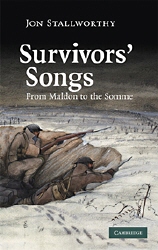Survivors’ Songs: From Maldon to the Somme – Book Review
 Survivors’ Songs: From Maldon to the Somme. Jon Stallworthy. Cambridge University Press, 2009, 226 pgs, notes, index. $29.95, hardback.
Survivors’ Songs: From Maldon to the Somme. Jon Stallworthy. Cambridge University Press, 2009, 226 pgs, notes, index. $29.95, hardback.
Survivors’ Songs is not a history book, per se. It is a literary review of war prose and poetry as affected by the battlefields of World War One, especially the Somme.
The history of war has been recorded in many different ways. The earliest ways was in tales and song around campfires and lodges of the warrior and his family and tribe. Next were the rudimentary cave paintings that revealed the combat between man vs. man and man vs. nature. Then with the development of the written word came both prose and poetry on war which included the epic poems so familiar to the modern reader from the antiquities such as Beowulf and The Iliad and The Odyssey. The next form was the visual arts age which covered paintings and photography and even sewing (Bayeux Tapestry) as recorders of war. Finally the recording of war and combat has become an audio-visual record with news films, television and movies. Survivors’ Songs by Jon Stallworthy is a literary review of the poems of war — along with a very limited amount to prose — and how the reflections of war changed with the carnage and brutality of the First World War and its effect on the poet-soldier.
{default}Survivors’ Songs gets its title from one of the earlier types of poetry where the poet speaks for those who have died. In this case Jon Stallworthy speaks for those soldier-poets who did not survive the war as well as for those who did. The book starts out with a generalized review of war poetry to show how the heroic figure in the war-poem has changed from the classical hero to the more modern anti-hero everyday man. The second chapter returns to the title of the book and explores the idea that the poet/survivor has an obligation to tell the reader the truth of the matter and not to glamorize the events. As can be imagined, the shock of the carnage and brutality of the First World War played a central role in this sea change of the poetry world.
Following these overviews the author goes into in-depth analysis of various distinct ideas. For example, one chapter explores England’s great epic The Golden Warrior by Hope Muntz, a rare case of Stallworthy giving a work of prose significant attention. Published in 1948, The Golden Warrior deals with the legacy of the Norman invasion of England by William the Bastard (William the Conqueror) and his defeat of the Saxon king Harold. The author notes the writer (Muntz) not only combined high level historical research to her work, but was also influenced by the realism then being incorporated by the poets of World War One and World War Two.
The next chapters seem to wander from place to place. Some are in-depth explorations of various poets, but interspersed with these are various thematic chapters which cover such aspects of poetry as Christ as the Soldier, the battlefield as depicted as a wasteland, the air war, and the fury over the wastefulness of war. Much of what Jon Stallworthy writes can be equated by the old American Civil War statement, "Rich Man’s War; Poor Man’s Fight." The idea that came from the Somme and all the other battlefields of World War One was that there is no glory in war, only survival. It can also be said that the poets were compelled to tell of the horror of war so that future generations would not march gleefully into war on the notion that it was like sports — which had been the imagery prior to World War One and into the first years of that conflict.
Survivors’ Songs is not a history book, per se. It is a literary review of war prose and poetry as affected by the battlefields of World War One, especially the Somme. The research is first-rate and the writing crisp for the most part. However, there are parts where the reader is bogged down and frankly confused on exactly what point the author is trying to get across. Despite this, Stallworthy made me curious about the prose of Siegfried Sassoon and the poetry of Wilfred Owen. Unfortunately, as the book is very much a niche work it can not be recommended for the general historian. It would be more suitable for a university – level literature review course. If one is interested in the evolution of poetry in war, then the book is very definitely recommended. With a list price of $27.99 the book is easily affordable by most readers. This review is for the new softbound version published on January 8th, 2009.
ACG Intel
Survivors’ Songs: From Maldon to the Somme


Military War Society
Military history is the cadence of music to
marching troops with their leaders at the head.
War history is the blaring noise of everything
until the silence covers the dead.
War and society is the changing of life because
of the war and the memories that are blood red.
Nate Fultz 2006
I offer my poetry for your reading.